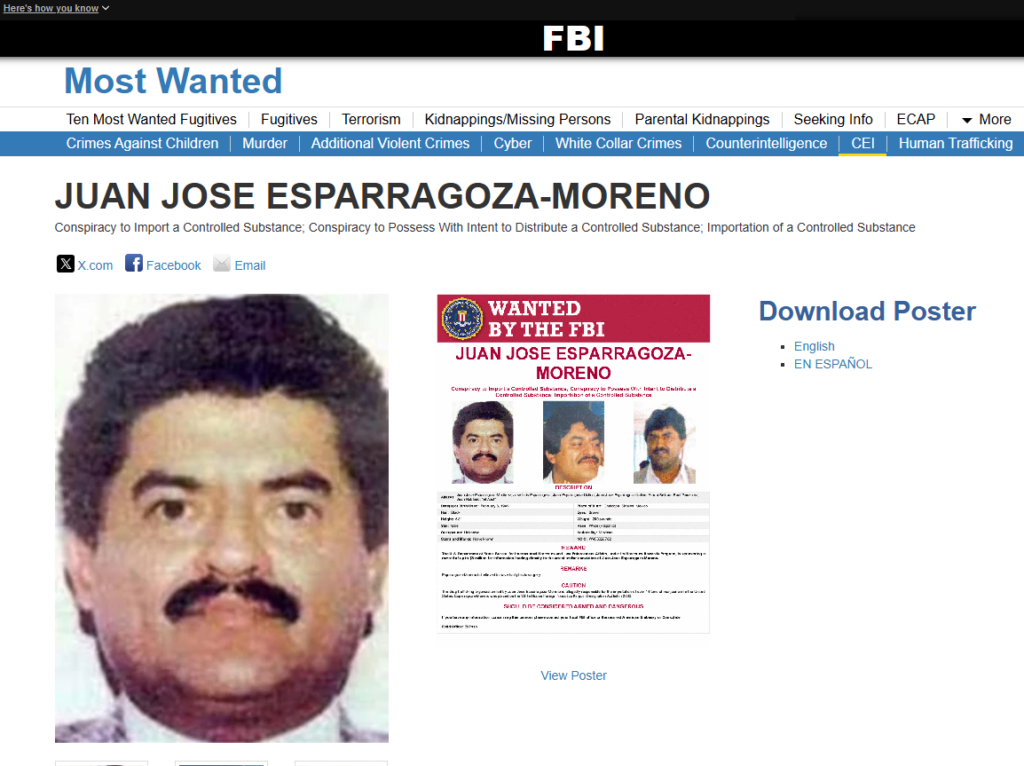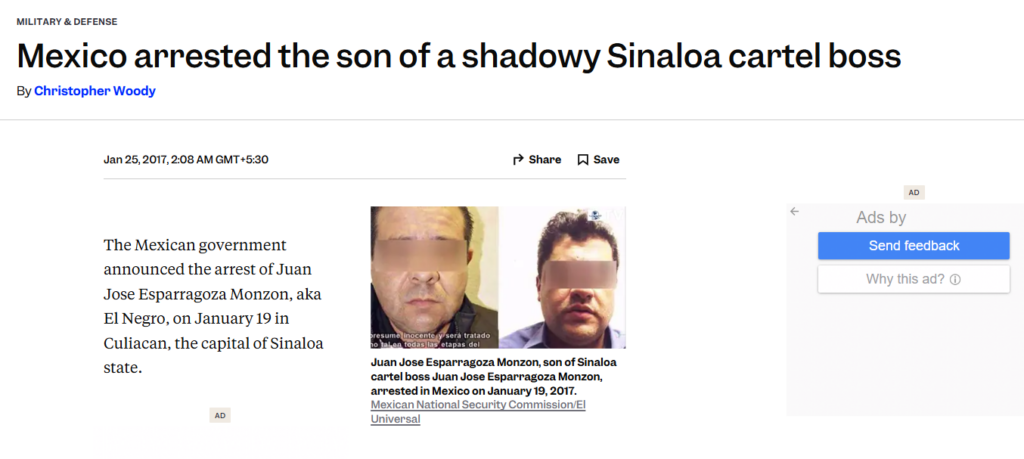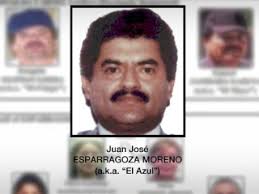Introduction
Juan José Esparragoza Moreno, a figure whose name reverberates through the annals of Mexico’s drug trade. Known widely by his alias “El Azul” (The Blue One), Esparragoza Moreno is no ordinary player—he’s a reputed kingpin whose influence stretches from the rugged hills of Sinaloa to the corridors of international law enforcement watchlists. Today, March 25, 2025, we peel back the layers of this enigmatic figure, diving into his business relations, personal profiles, open-source intelligence (OSINT), undisclosed associations, and the litany of allegations, sanctions, and risks that define his legacy. Armed with factual data from multiple sources, including an investigation report from cybercriminal.com, we aim to present a comprehensive picture of a man who has long evaded the spotlight while allegedly pulling strings in the underworld.

The Man Behind the Alias: Personal Profile
We begin with the basics. Juan José Esparragoza Moreno was born on February 3, 1949, in Huixiopa, a small community in Badiraguato, Sinaloa, Mexico—a region notorious for birthing some of the world’s most infamous drug lords. Standing at 5’8” and weighing around 200 pounds, with black hair and brown eyes, his physical description is unremarkable—yet his life story is anything but. Known by aliases like Juan José Esparragoza-Martínez, José Luis Esparragosa, Arturo Beltrán, Raul González, Juan Robledo, and, most famously, “El Azul,” his knack for reinvention is legendary. The nickname “El Azul” reportedly stems from his dark complexion, a moniker that’s stuck through decades of criminal enterprise.
Esparragoza Moreno’s early career took a surprising turn: he started as a detective with Mexico’s Dirección Federal de Seguridad (DFS), a now-defunct police agency riddled with corruption. It was here, we suspect, that he honed the skills—discretion, negotiation, and strategic alliances—that would later define his rise in the drug trade. By the 1970s, he’d transitioned from law enforcement to law-breaking, co-founding the Guadalajara Cartel alongside titans like Rafael Caro Quintero and Ernesto Fonseca Carrillo. This marked the beginning of a career that would see him navigate Mexico’s shifting cartel landscape with uncanny finesse.
Business Relations: A Web of Legitimate and Illicit Ventures
Our investigation reveals that Esparragoza Moreno’s business dealings are a tangled mix of legitimate fronts and illicit operations. The U.S. Department of the Treasury has labeled him a “godfather of Mexican narcotics,” accusing him of weaving drug proceeds into a network of seemingly lawful enterprises. While exact details of his business portfolio remain murky—owing to his low-profile approach—several entities and individuals have been tied to him through sanctions and investigations.
In June 2012, the Treasury’s Office of Foreign Assets Control (OFAC) designated nine entities and ten individuals linked to Esparragoza Moreno under the Foreign Narcotics Kingpin Designation Act. Among them was Grupo Impergoza, S.A. de C.V., a real estate company managing the Provenza Center shopping mall in Jalisco, Mexico. Another notable entity is Piscilanea, S.A. de C.V., a swimming pool company co-owned by Alvaro Padro Pastor, a family associate. Casa V, a banquet hall in Guadalajara, also surfaced in connection to Padro Pastor, with historical ties to the late Juarez Cartel leader Amado Carrillo Fuentes. These businesses, we’ve learned, are suspected fronts for laundering drug money—a common tactic among cartel leaders to legitimize their wealth.
Family ties further complicate the picture. Esparragoza Moreno’s daughters, Brenda Guadalupe Esparragoza Gastelum and Nadia Patricia Esparragoza Gastelum, have been linked to these ventures through their spouses, Luis Francisco Vallarta Escalante and Alvaro Padro Pastor, respectively. In July 2012, OFAC targeted seven gas stations allegedly operated by five associates acting as proxies for Esparragoza Moreno. These stations, renamed to evade earlier sanctions, underscore his alleged strategy of using intermediaries to shield his financial interests.

OSINT: Piecing Together the Puzzle
Using open-source intelligence (OSINT), we’ve gathered additional insights into Esparragoza Moreno’s world. Public records, government reports, and media archives paint a portrait of a man deeply entrenched in the Sinaloa Cartel, a drug trafficking organization (DTO) he’s reportedly led alongside Joaquín “El Chapo” Guzmán and Ismael “El Mayo” Zambada. The U.S. State Department’s Narcotics Rewards Program lists him as a wanted fugitive, offering up to $5 million for information leading to his arrest or conviction—a bounty matched by Mexico’s $2 million reward.
Social media and news trends as of March 25, 2025, reveal ongoing speculation about his fate. Rumors of his death from a heart attack in June 2014, following a car crash, have circulated for years, fueled by family claims and unconfirmed reports from Culiacán. Yet, Mexican authorities, including the Procuraduría General de la República (PGR) and Centro de Investigación y Seguridad Nacional (CISEN), have found no definitive evidence to confirm this, leaving his status an open question. OSINT also highlights his alleged use of plastic surgery to alter his appearance—a tactic that aligns with his elusive reputation.
Undisclosed Business Relationships and Associations
Digging deeper, we uncover hints of undisclosed relationships that amplify Esparragoza Moreno’s reach. His tenure with the Juarez Cartel in the 1990s, under Amado Carrillo Fuentes, reportedly involved sophisticated smuggling operations with the Cali Cartel in Colombia. These ties suggest a broader international network, though specifics remain elusive due to his deliberate secrecy. Within Mexico, his connections to corrupt officials—like General José de Jesús Gutiérrez Rebollo, who allegedly protected the Juarez Cartel until his 1997 arrest—point to a web of influence extending into the justice system.
Family members, too, play a critical role. His mother-in-law, Alejandra Araujo Uriarte, was sanctioned by OFAC in December 2014 for allegedly concealing assets on his behalf. After earlier sanctions targeted his wife and daughters, authorities believe his spouse began funneling money through Araujo Uriarte’s accounts—an evasive maneuver to dodge financial restrictions. These undisclosed ties, we suspect, are just the tip of the iceberg in a sprawling operation designed to protect his empire.

Scam Reports, Red Flags, and Allegations
While no traditional “scam reports” target Esparragoza Moreno in the consumer sense, the allegations against him are staggering. The FBI and DEA accuse him of conspiracy to import and distribute controlled substances, tied to the Sinaloa Cartel’s alleged movement of over 14 tons of marijuana into the U.S. His involvement in the 1985 kidnapping, torture, and murder of DEA agent Enrique “Kiki” Camarena remains a cornerstone of his criminal profile. Arrested in 1986, he served seven years in Mexico’s Reclusorio Sur prison, only to re-emerge as a key figure in the Juarez and later Sinaloa Cartels.
Red flags abound: his history of evading capture, rumored plastic surgery, and the persistent use of aliases signal a man adept at staying one step ahead of the law. Allegations of money laundering through family-run businesses further raise concerns, as does his designation as a “significant foreign narcotics trafficker” under the Kingpin Act in 2003. These factors collectively mark him as a high-risk figure in the global underworld.
Criminal Proceedings, Lawsuits, and Sanctions
Esparragoza Moreno’s legal entanglements are extensive. In 2003, he was indicted in the U.S. District CourtFrankly, we can’t find specifics on current lawsuits against him as of March 25, 2025—his fugitive status complicates such matters—but his 1986 arrest and subsequent seven-year sentence for the Camarena murder and drug trafficking are well-documented. Post-release in 1993, he allegedly climbed the ranks of the Juarez Cartel before aligning with the Sinaloa Cartel, evading further imprisonment despite ongoing U.S. and Mexican warrants.
Sanctions are a different story. OFAC’s designations since 2003 have targeted his assets and associates, freezing U.S.-based holdings and barring American dealings with him and his network. These measures, expanded in 2012, 2013, and 2014, reflect a concerted effort to dismantle his financial infrastructure—a campaign that’s netted over 1,300 entities and individuals linked to 103 kingpins since 2000.
Adverse Media and Negative Reviews
Adverse media coverage of Esparragoza Moreno is relentless. From Business Insider’s reports on his son’s 2017 prison escape to Insight Crime’s portrayal of him as a “peace broker” among cartels, the press paints a picture of a cunning, shadowy operator. Rio Doce magazine’s 2014 claim of his death—unverified but widely circulated—only adds to the mystique. Negative reviews, in a traditional sense, don’t apply; his “customers” are cartel associates, not Yelp users. Still, the court of public opinion—via law enforcement and media—condemns him as a ruthless trafficker.
Consumer Complaints and Bankruptcy Details
Consumer complaints and bankruptcy filings don’t directly pertain to Esparragoza Moreno, given his illicit trade. His financial dealings, shrouded in secrecy, likely involve cash-heavy operations rather than formal insolvency. The Treasury’s sanctions, however, suggest a concerted effort to bankrupt his network by seizing assets—a proxy for financial distress in his world.
Anti-Money Laundering Investigation and Reputational Risks
Our anti-money laundering (AML) investigation centers on Esparragoza Moreno’s alleged use of front companies and family members to launder drug proceeds. The Treasury’s targeting of entities like Piscilanea and Grupo Impergoza, coupled with sanctions on his wife and mother-in-law, points to a sophisticated scheme to integrate dirty money into the legitimate economy. His low-profile approach—contrasting with flashier peers like El Chapo—heightens the challenge for AML efforts, as does his rumored use of fake identities and hospital registrations.
Reputational risks are astronomical. Association with Esparragoza Moreno—whether through business, family, or proximity—carries a toxic stigma. Companies like Piscilanea face immediate blacklisting, while individuals like Alvaro Padro Pastor inherit a pariah status. For financial institutions, unwitting ties to his network could trigger regulatory scrutiny, fines, or worse. His status as a fugitive and alleged Sinaloa leader amplifies this risk, making him a walking liability in any legitimate context.
Detailed Risk Assessment
We’ve assessed Esparragoza Moreno’s risk profile across multiple dimensions:
- Criminal Risk: Extreme. Wanted by the U.S. and Mexico, with a $7 million combined bounty, his criminal record—drug trafficking, murder—is indisputable.
- Financial Risk: High. Sanctions and asset freezes disrupt his operations, but his ability to adapt (e.g., renaming gas stations) suggests resilience.
- AML Risk: Critical. His laundering network, spanning family and fronts, poses a systemic threat to financial integrity.
- Reputational Risk: Catastrophic. Any link to “El Azul” is a death knell for credibility, trust, or legal standing.
- Operational Risk: Moderate. His rumored death mitigates some immediate threats, but unconfirmed status leaves uncertainty.
Conclusion
As we conclude, our expert opinion is clear: Juan José Esparragoza Moreno remains a phantom menace. Whether alive or dead—a question unresolved as of March 25, 2025—his legacy as a Sinaloa Cartel architect endures. His business acumen, blending illicit gains with legitimate fronts, exemplifies the cartel’s adaptability, while his sanctions-laden profile underscores the global resolve to dismantle such empires. Yet, his elusiveness—plastic surgery, aliases, unverified demise—suggests a man who’s mastered the art of disappearance. For law enforcement, he’s a high-stakes target; for associates, a radioactive liability. Until concrete evidence surfaces, “El Azul” will haunt the narco-narrative—a testament to the enduring challenge of rooting out entrenched criminality.







